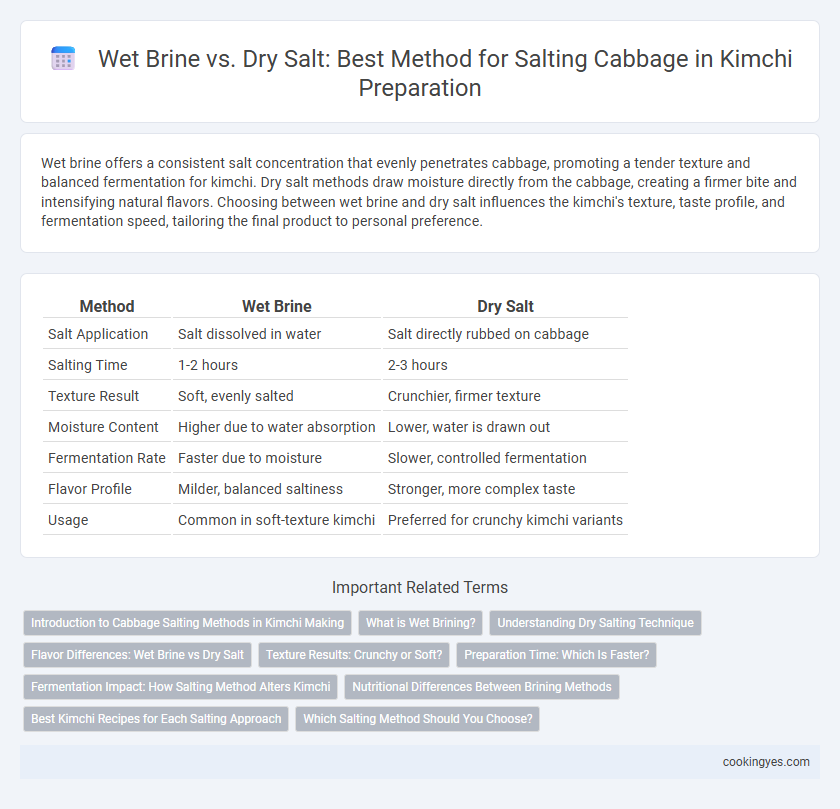Wet brine offers a consistent salt concentration that evenly penetrates cabbage, promoting a tender texture and balanced fermentation for kimchi. Dry salt methods draw moisture directly from the cabbage, creating a firmer bite and intensifying natural flavors. Choosing between wet brine and dry salt influences the kimchi's texture, taste profile, and fermentation speed, tailoring the final product to personal preference.
Table of Comparison
| Method | Wet Brine | Dry Salt |
|---|---|---|
| Salt Application | Salt dissolved in water | Salt directly rubbed on cabbage |
| Salting Time | 1-2 hours | 2-3 hours |
| Texture Result | Soft, evenly salted | Crunchier, firmer texture |
| Moisture Content | Higher due to water absorption | Lower, water is drawn out |
| Fermentation Rate | Faster due to moisture | Slower, controlled fermentation |
| Flavor Profile | Milder, balanced saltiness | Stronger, more complex taste |
| Usage | Common in soft-texture kimchi | Preferred for crunchy kimchi variants |
Introduction to Cabbage Salting Methods in Kimchi Making
Cabbage salting methods in kimchi making primarily include wet brine and dry salt techniques, each influencing fermentation and texture differently. Wet brine involves submerging cabbage in a saltwater solution, promoting even salt penetration and moisture retention, while dry salting applies salt directly to the cabbage, drawing out water and creating a firmer texture. The choice between these methods impacts the kimchi's taste, fermentation speed, and overall quality.
What is Wet Brining?
Wet brining for kimchi involves submerging cabbage in a saltwater solution to draw out moisture and initiate fermentation, enhancing texture and flavor development. The salt concentration typically ranges between 5-7%, which inhibits unwanted bacterial growth while promoting beneficial lactic acid bacteria. This method ensures even salt distribution, resulting in a crispier and well-balanced fermented cabbage ideal for traditional kimchi recipes.
Understanding Dry Salting Technique
Dry salting cabbage for kimchi involves evenly coating cabbage leaves with coarse sea salt, which draws out moisture through osmosis, resulting in a crispier texture compared to wet brine methods. This technique requires massaging the salt into the cabbage and allowing it to sit for several hours, promoting fermentation by creating an ideal environment for beneficial lactobacillus bacteria. Mastery of dry salting enhances kimchi's flavor development and preserves the vibrant crunch essential to traditional Korean cuisine.
Flavor Differences: Wet Brine vs Dry Salt
Using wet brine for cabbage salting in kimchi results in a milder, more uniformly salty flavor with enhanced moisture retention, which promotes a tender texture and balanced fermentation. Dry salt application concentrates flavors by drawing out water and intensifying cabbage's natural sweetness, leading to a crunchier texture and a more pronounced umami profile. The choice between wet brine and dry salt directly influences the depth of flavor complexity and texture in traditional kimchi preparation.
Texture Results: Crunchy or Soft?
Wet brine salting for kimchi cabbage results in a softer, more tender texture due to the cabbage absorbing moisture evenly during fermentation. Dry salt salting draws out excess water from the cabbage, preserving a crunchier bite by maintaining firmer cell structure. Choosing between wet brine and dry salt affects the kimchi's texture, with wet brine yielding softness and dry salt enhancing crunchiness.
Preparation Time: Which Is Faster?
Dry salt salting significantly reduces preparation time for kimchi cabbage by drawing out moisture more quickly compared to wet brine, which requires cabbage to soak for several hours. Wet brine involves submerging cabbage in salted water for about 6 to 8 hours to achieve proper salting and texture. Dry salt achieves similar results in approximately 2 to 3 hours, making it the faster option in kimchi preparation.
Fermentation Impact: How Salting Method Alters Kimchi
Wet brine salting ensures even salt penetration, promoting consistent fermentation and a softer kimchi texture, while dry salting draws moisture out more gradually, contributing to a crunchier bite and complex flavor development. The choice between wet brine and dry salt directly influences lactic acid bacteria activity, with wet brine accelerating fermentation rates and dry salt fostering a slower, layered microbial growth. These differences impact kimchi's taste profile, acidity, and preservation timeline, making salting method a critical factor in traditional fermentation outcomes.
Nutritional Differences Between Brining Methods
Wet brine salting for kimchi cabbage typically retains higher moisture content, preserving water-soluble vitamins like vitamin C and B-complex, while dry salt methods concentrate minerals such as sodium and potassium due to less dilution. The wet brine process may reduce nutrient density slightly because of leaching effects, whereas dry salting promotes enzyme activity and fermentation, enhancing probiotic content and bioavailability of certain nutrients. Choosing between wet and dry salting impacts kimchi's overall nutritional profile, balancing vitamin retention against mineral concentration and probiotic development.
Best Kimchi Recipes for Each Salting Approach
Wet brine salting, using a saltwater solution, enhances kimchi's crisp texture and evenly penetrates cabbage, making it ideal for recipes emphasizing juiciness and balanced fermentation like traditional Baechu Kimchi. Dry salt salting draws moisture directly from cabbage leaves, producing firmer, chewier kimchi suited for recipes requiring a denser texture and concentrated flavors, such as spicy Nabak Kimchi. Selecting the right salting method depends on the desired kimchi texture, fermentation speed, and flavor intensity in each recipe.
Which Salting Method Should You Choose?
Choosing between wet brine and dry salt for cabbage salting depends on desired texture and flavor intensity in kimchi. Wet brine, involving submerging cabbage in salty water, enhances uniform salt absorption and results in a softer, more tender texture. Dry salting, rubbing salt directly onto cabbage leaves, offers a crunchier bite with stronger fermentation flavors, making it ideal for traditional kimchi enthusiasts seeking a robust taste profile.
Wet Brine vs Dry Salt for Cabbage Salting Infographic

 cookingyes.com
cookingyes.com